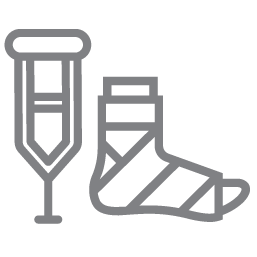 Rehabilitation Center
Rehabilitation Center

What is Rehabilitation Medicine?
Rehabilitation Medicine is a department that is responsible for taking care of and providing treatment for the physical rehabilitation of patients in order to restore their bodies to their former efficiency. Movement of the body is something that everyone desires, but diseases that negatively affect body movement can take many forms, including those related to bones, nerves, and muscles, or physical problems that have existed since birth. These can make life difficult and even lead to serious disabilities such as paralysis. Our rehabilitation medicine is ready to treat abnormal muscle conditions, not only through treatment but also through evaluation and advice on preventing related diseases.
____________________________________
For further information, please contact
Days of operation: Monday - Friday
Operating hours: 8:00am-8:00pm
Building/Floor: B/2
Contact number: 1390 ext. 166, 167
Line Official : @petcharavej click
Physical Therapy Center
-
When patients have suffered from various serious diseases and have undergone treatment, sometimes there may be residual impacts from those diseases, such as damage to the muscles leading to problems with movement, or people who have had muscle problems since birth can receive muscle rehabilitation to restore normal function and quality of life.
Medical Services
-
Treatment of spinal cushion diseases
-
Treatment of spinal cushion diseases with nerve compression
-
Treatment of shoulder pain, neck pain, knee pain, and back pain
-
Treatment of hemiplegia
-
Hip joint replacement
-
Facial paralysis
Doing Basic Physical Therapy
-
Positioning patients in normal positions for sitting, lying down, and other positions to reduce muscle tension and organ stiffness in those areas.
-
Relaxing muscles, combined with rehabilitation to improve mobility, in order to allow patients to exercise the affected muscles more effectively.
-
Exercising various joints, such as sitting and standing, to prevent joint deterioration.
Precautions during exercise
-
Patients should perform exercises slowly and avoid rushing.
-
Be careful not to move beyond the limits of the body, but should move to the fullest extent of the organs.
-
Perform exercises 10-20 times per day.
-
Patients should try to move on their own, but should be under the care of those around them.
-
Avoid exercising after eating new meals.
-
If any problems occur during exercise, stop immediately and seek medical diagnosis.
-
Patients should sit or change positions frequently and should not lie down for long periods.
Exercises that can be done at home
-
Stand with legs apart, knees bent at a 90-degree angle, and hold for 20 seconds with shoulders squared: Helps with balance.
-
Draw a line and walk along it for about 5 meters, for a maximum of 10 rounds: Helps with balance.
-
Stand straight, raise both hands while inhaling and lower them while exhaling, repeating 8-10 times: Helps with lung exercise.
-
Sit on a chair and alternate straightening your knees, repeating 8-10 times: Helps with knee exercise.
-
Sit with one knee straightened and the other knee bent towards the body, and touch the toes of the straightened leg while bending forward and holding for 10 seconds: Helps with leg exercise.
-
Lie on the floor with one leg straightened and lift it up and down 8-10 times: Helps with calf exercise.
-
Lie on the floor with both knees bent and twist the waist to the left and right 8-10 times: Helps with waist exercise.
-
Lie on the floor with both knees bent and lift the hips up and down 8-10 times: Helps with hip exercise.
-
Lie on the floor and hug both knees, pressing them against the chest: Helps with back pain relief.
-
Lie on the floor and lift both arms up while inhaling and lower them while exhaling: Helps with lung exercise
